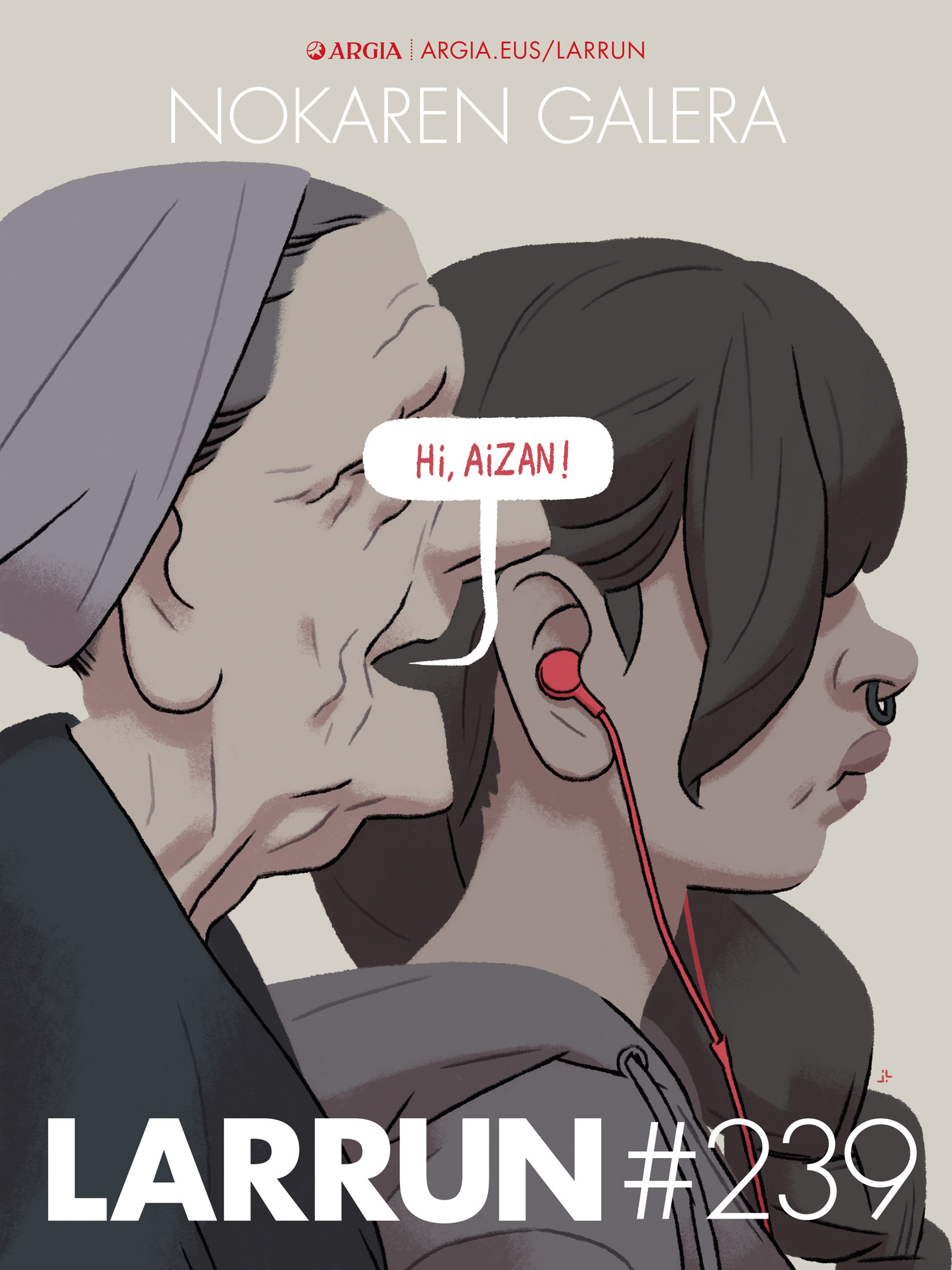Can feminism revitalize what is undervalued by sexism?
- That which is of no use, that of the dwelling, that which is passed by a man, the rude, the ugly, that of the rope divers, the violent, that is altered, and sin as well. Noka has been adhered to the ‘jewelry’ for years. Anyone who would like to be a pure, female woman would send her language as far as possible. Sexism has lasted to this day and noka has almost died. However, here and there they are taking mushrooms. Young women, almost all of whom are feminists, have regained their tutoring and have begun to talk about the notion of the corner. They believe it can be an important tool for the empowerment of women. In both cases, courses are being organized. They have helped us to find the causes of the loss Karlos Aretxabaleta de Bedia, of the Arratia valley, Garbiñe Bereziartua de Azpeitia, Onintza Legorburu de Antzuola and Eli Pagola de Hernani. We have also talked about the small recovery.

.jpg)
From Antzuola
Onintza Legorburu Larrea
Graduated in Social Work from the University of the Basque Country
It was born in Ugarte Torre de Antzuola in 1993. Unlike many houses, her family transmitted Hitano to the two sisters. However, they played each other in the street. First because of the obstinacy of the mother and then as a political choice, today noka eta toka. In the Master of Feminist and Gender Studies the study “Antzuolan noketan: What’s going on?” through interviews and observations.
Will Hika speakers be authentic Euskaldunes in Antzuola?
Onintza Legorburu is the mother of Taliban Hika. He's the great fan, but the rest of the house hasn't stayed behind. The father is also engaged in tutoring Onintza and his sister, as well as his uncles. At least grandmothers. Even though they picked them up, their sisters made juice, even on the street. Three years ago, when the two sisters started fighting each other, she won the obstinacy of her mother. Then they were joined by our cousin. The questions come to Legorburu reviewing his experiences with the noka: “In Antzuola there are a lot of people between 50 and 60 years old who hika. The girls of my age are playing, the mixed groups play or play and the boys play. The kids have not learned at home, but on the street. We've picked it up at home, and we're rolling among ourselves. What weight does gender have there? What influence has gender had on the loss of noka or on the survival of toka?
In order to find answers to his questions, he conducted twelve interviews and two observations on the poteo path of Antzuola. He chose bars because those over the age of 19-20 come together in these places. These men play as children, at least on the street, and Legorburu wanted to know when they change or change the language. He has found two factors to make the change. On the one hand, in adolescence, the boys change from group to group, and the three- or four-year-olds start walking together. On the other hand, boys meet at Jakin's tavern, girls don't. People over the age of 18 and up to 40 can be found in the same bar. Changing from zuka to hika becomes, so to speak, the key to change to maturity, serves to strengthen virility, helps build identity. It has prestige in this context.
“The kids have not learned at home, but on the street. We've picked it up at home, and we're rolling among ourselves. What weight does gender have there? What influence has gender had on the loss of noka or on the survival of toka?”
In order to create a more global vision, Legorburu has worked three areas of life in which the hika is used or has been used in Antzuola.
In leisure time, the use of the bar has been analyzed. The boys seemed to attach the Hitano with speed, vitality, movement. Short sentences, quick answers… and body expression. She observed how women and men moved in the tavern. Men occupied more space when talking and moved their bodies more. “So, does such a body have a better tuteo?”
In the world of work it has differentiated between work in the field and work in the industry. In the works of the farmhouse there are very nice examples of the distinction between genders. The 59-year-old woman told her how she was going to go to Bergara to sell the house stuff and how she was doing the juice to shoppers, “How was she going to tweet the shopper?” However, the 90-year-old woman told her what her father was going to the fair and reproduced the deals her father had through the tuteo, “how would she do it, because she knew nothing else?” The rules of courtesy we have in society also influence dialogue. The woman who was going to sell to Bergara wanted to mark the distance with the buyer and used the juice. His father, who was heading for the market, wanted to have a friendly relationship and was engaged in tutoring. The laws of courtesy, like the laws of the Hitans, affect women and men differently.
The young people who work in the factories of the people have broken the social norm of age. Most do not bring home Hitano, but at work the older ones do the tuteo. So young people are also beginning to tweet and older people are doing the same.
As for the school environment, the interviewed women told her that they had not used Hitano and that the men did it with their classmates. The woman has surrendered, even in school. Hitano has not been a standard in education and it is possible that women turn away from what is not the norm, leave the Hitan and use the zuka. The men, on the contrary, would have been led against the norm or simply by the Hitan they already had.
.jpg)
Ask the Contertulia directly why noka has been lost and Legorburu takes up three main arguments:
Transmission gap: The female interlocutors tell you that they did not receive it from home. Legorburu doesn't get the bills out: “Many kids have also learned the toka on the street, they haven’t picked it up at home. Now on the street you can't learn noka, but then, why didn't you learn noka on the street?" The anthropologist Jone Miren Hernández has copied the question she asks about Euskera for this situation: What gives men the touch? And so says Legorburu: “It helps them develop their personality, it’s a great tool for building fraternal relationships. Noka doesn’t have it.” Therefore, the interruption of transmission does not explain everything.
The loss of the Basque: in the loss of the Hitan, the loss of the Basque country has much to say, for example, in the Franco era. But in Antzuola, as in other villages, women resorted more to Spanish. It's the woman who changes language or jumps from the hika to the zuka. Legorburu relates this change of language with power: “The non-power clings to what is prestigious, or to Spanish, or in this case to the zuka.”
The division between the public and the private: women have been socialized in the private spaces. If there's been a court in the house, when and where do young people start? In leisure time and in the workplace, in masculinized areas.
Hitano: rustic, tosco…
Many beliefs and values about Hitan have been negative. The interlocutors have related Hitano with the following terms: uselessness, rudeza, peasinism, small town account… Legorburu says: “The last three terms do not marry femininity. If I want to be a lady, what am I going to do? Unlink the language of that treatment! On the other hand, it is not in contradiction with hegemonic masculinity”.
Confidence and closeness are positively valued by the interlocutors. But it's curious what women who haven't received the Hitan at home say. In other words, the parents considered the Hitman to be a lack of respect, and the ecclesiastics also spoke to that extent. This clashed with morality and women, even through language, had a responsibility to preserve morality.
Young people feel guilty
These are the signs of a paradigm shift that detect pulling away from what the two boys they touch and the two girls they noka say. Speaking Hitan gives young people a personality and, in this connection, an authenticity or a kind of label. Local identity: “I’m from Antzuola and hika.” They associate him to be a good vasco-speaker, as well as getting tuition in Basque.
It is a political choice for Legorburu to recover the noka. It has also started to use the toka. Even if it is symbolically, he has realized that relationships are made as if they had been equalized: I will touch you and you have two options, or you will do yourself or learn and do noka.
Can Hitman be an instrument to empower women?
Legorburu believes yes, and has mentioned two forms of empowerment. On the one hand, if we change language habits, we become active speakers and demonstrate agency. This agency, women, has been prevented for many years. In addition, she says that women get into a totally masculinized space, that learning noka is also going into the masculine world, because young women have lost both noka and toka. On the other hand, it has paralleled the experiences of the new Basque: to lose shame, to empower oneself, to learn, to dare to use it…
It all started with the mother... now feminism has caught him.
It is a political choice for Legorburu to recover the noka. Now, the three family members have also started using the toka, which has already been removed. Even if it's symbolically, they've realized that relationships are made as if they've matched up: I'm going to touch you and you have two options, or you're going to make yourself or you're learning and doing noka. In mixed groups, men continue to speak in front of women. In Legorburu's opinion, first women have to make an effort to recover the noka, and then men should follow the path: “Men use two types of linguistic treatment and we use one. Gender has had a great deal of weight in it. Feminism is a terrible tool for this recovery and to fight against what has been forbidden to us, and the strongest social movement is feminism in the Basque Country, far beyond the Basque country.”
Neutral Hitano?
The Hitan distinguishes two genres, it's based on that. In this sense, Legorburu understands that for some feminisms Hitan is not valid, but he, as a political subject, as a woman, wants to claim the recovery of the Hitan. Theoretically he agrees to invent a neutral Hitano, but in practice it does not seem feasible: “Are we few speakers and in order to recover the Hitan we must create a neutral Hitan? The recovery of the hitman will be made and forced with full conscience, let us take advantage of this process.”

From Azpeitia
Garbiñe Bereziartua Etxeberria
Professor and Researcher at the University of the Basque Country
He was born in Azpeitia in 1977. In adolescence, Noka has been in favor of abandoning and using the prestigious nozzle. Years later he realized that noka was disappearing because of gender discrimination. Today, noka with conscience and is doing research work with Beñat Muguruza on “The Hitan in Azpeitia: a proposal for intervention for use, situation and regeneration”. He works in the Department of Teaching Language and Literature of the School of Magisterium of San Sebastian.
Are you sure the Hitan is healthy in Azpeitia?
Azpeitia is the most Basque town in Euskal Herria with over 10,000 inhabitants. The Basque is very strong in that town in the valley of the Urola and it can be said that the Hitan is also healthy. However, researchers Garbiñe Bereziartua and Beñat Muguruza prefer to relativize the excellent state of health. So they ask: “To what extent hika in Azpeitia?” Seeing that it is not as healthy as you want, you have decided to ask the Azpeitiarras. The results confirm the assumptions: young people work less than adults and women less than men.
The Sociolinguistic Cluster used the methodology of the use of the street to measure the use of the hika in the streets of Azpeitia, and the couple Bereziartua-Muguruza has worked on a different method to obtain results, that is, it has launched a series of questions to the citizens. 850 adults, 67 per cent of whom are women. In total, 397 young people have answered the questions raised by all the 12-18 year-olds who are in educational institutions. A total of 333 4th and 6th grade elementary students have also responded.


In the two tables above you have the most significant results. Researchers have gathered several conclusions:
1.Como was expected, there is a big difference between boys and girls in both what they do and what they receive. Girls get less and girls get less. The answers of the young people to the question about why not do so much Hika are significant. 43.3% of the girls say they do not know how to do what they want, compared to 12.3% of the boys. 40.4% of the girls feel strange, while 12.9% of the boys do. Twenty-four percent of girls say their friends don't, and boys who say the same thing are only 3.2 percent.
2 Differences are also important in terms of age. The younger you are, the less you'll make use of your own.
3.Hay a great tendency to touch girls. Boys touch them, but girls also touch them. According to the researchers, these data allow a deeper reflection.
4.Desean do more than they do. Above all, women have said so. This desire was expressed by 65.4% of young women and by 46.7% of young men. It must be borne in mind that young men speak more than young women.
These results indicate that the first phase of the long-term investigation has been completed. They have noted that the state of health is particularly precarious and in the second phase they want to analyse the reasons for this. They're going to start doing it in the spring. Individual interviews, group discussions and case analysis will be conducted (citizens who have not used Hitano will be placed and monitored). In the third phase, gathering all this information, we will analyse what they would do in Azpeitia to recover the Hitan and try to get it going.


From Arratia
Karlos Aretxabaleta Ormaetxea
High school teacher
He was born in Rwanda in 1990. He currently lives in the village of Bedia, in the Arratia valley. He has carried out the study “The Loss of the Nacedero of Arratia during the twentieth century”. It has been devoted to noka fishing in many towns and villages in the neighbourhoods of Arratia. In this valley there has been a great loss of noka and only the older woman has found those who noka work. He has studied Magisterium and Basque Philology.
In Arratia only the Duendes make noketan
Karlos Aretxabaleta has analyzed the loss of use of the Noka in the Arratia valley. In this region of Bizkaia, the loss of Hitano, and even more so the loss of noka, is evident. Aretxabaleta wanted to know when and why it has been lost. To begin to delve into the subject, it has given us an incomparable reflection: “In the valley the women who know Hitan are like a treasure, they are very few, and also it is not about knowing noka or not, but they are ashamed to admit that they are able to speak. Men do it in Hitano, I do it too, and we are not ashamed of it. Why are women ashamed? Why don’t they speak quietly?”
Aretxabaleta has travelled villages around the lands of Arratia. During long conversations, in the kitchen of the house, old women have told her how she was tweeting or doing it before. After trusting the interviewer, suddenly, the woman starts to argue with her partner, who is next to her. Aretxabaleta calls women to night goblins, when they have the researcher in front of them talk about the loss of the noka, but they hide that they are able to speak in that language. The researcher says that he has to start again from farmhouse to farmhouse, looking for goblins.
“If we knew the short story and knew why we lost it, we would know that patriarchal society has made us lose, maybe we would try to recover it.”
It was clear that the loss of noka was closely linked to the destruction of the rural world. The baserritars left the Arratia valley to work at the end of the 19th century in Bilbao. Above all, the women were to be raised to arm themselves as soon as possible with the money. It was more common for men to stay in housework. In Bilbao, in a strange context and in Spanish, women more easily resorted to Spanish and to the loss of the tutorial. The woman who lived the discrimination of gender in the skin took the behaviors more quickly so as not to be left out of the norms of society: if the Hitan makes me baserritarra, I will do the same, and if the Basque also makes me baserritarra, I will take as a language the Spanish.
However, the jump from the farmhouse to the city was not the only reason to lose the rope. Women over the age of 70 have been asked if they have been taught: “What for? Why? The hika is hard; it brings nothing; maybe if you work in the world of the farmhouse, we are the ones of always, of the people, but if not…”. It might be for the farmhouse, but there too… In fact, it was very common for the farmhouses to pass the tuteo on to their sons and not to their daughters. He asked the same women about the women who were in tutoring, and most of all they have agreed with the neighbors of Ibarra de Bedia: “They had a reputation for Andratona, women moved, they were strong, Ibarra’s neighbors have always had a terrible stone.” The woman had to be thin, female, and the you were considered vulgar. Aretxabaleta has a related question: “Has noka always been unseen because it was clumsy? As the writer Juan Manuel Etxebarria has said, men are able to talk about the failures of the garden and current problems, and why not with women or women?”

The Church put its share in a ban. He related Hitman to virility, cruelty, almost sin. The role for the woman was very marked and in this field the Hitan had no place. More than one woman interviewed pointed out that at home her parents had rebuked her for talking about hika and so many other Abades. Aretxabaleta would not say that the use of tuti by women was taboo, but it did have a stigma.
Very few, strong women have kept the hika and speak for use from legitimacy, “Why am I not going to talk about noka and toka?” But their use doesn't mean they've taught the offspring, that almost nobody has. Aretxabaleta has found the sisters who speak of hika based on trust and have given the impression that they do so naturally. But the researcher has the prepared question: “Do you trust each other and have no confidence in anyone else to touch you?” In very limited relationships you see noka jo atea, jo, jo, jo, jo, jo, in a hamlet.
Will young people address it?
The young women who know Aretxabaleta do not see Hitano as a means to prove their identity, it is not a gift for them, they consider it as something that men do. The researcher believes that there are two options, or discard or do it yourself. “If we knew the short story and knew why we lost it, we would know that patriarchal society has made us lose, maybe we would try to recover it.” You have heard that women between the ages of 50 and 60 want to do a short course with the intention of using what they know about hearing. Because it is not the same Hitan attitude that women over 80 years of age interviewed by Aretxabaleta and those around 50-60 have. For older people, Hitano has no value and for younger people, even if they have not used it or transmitted it, they are aware of the loss.

From Hernani
Eli Pagola
Bertsolari and graduated in renewable energy
He was born in the Ereñotzu district of Hernani in 1995 and has not stopped working since. At the age of 18, he started speaking Hika, a language he had only heard of until then. It holds the hika from the feminist conscience, and especially the Noka. In addition to working with friends, it's also changing language habits with bertsolaris, and it's also tested with bertsos. He has been a professor at the Bertsolaris School of Hernani since 2011. During the 2017-2018 academic year he was a professor of regulated teaching at the Bertsolaris Association of Gipuzkoa.
A simple example of young feminists in Hernani
Eli Pagola and his friends knew that at Hernani City Hall someone had made the proposal to teach Hitano. But it wasn't going to start. They decided to make a little effort until the course came out. This is a 30-year-old woman. The "you," and especially the "noka," wanted to get it back. Most of them came from the feminist movement. They started to learn Hitan almost from scratch. In any case, during the course, adult women who knew how to speak were joined, but who noticed that they did not have the daily language. They held 4-5 day sessions, without giving special importance to grammar, organized by a dynamic session.
Why did they start to recover the tuteo?
In the course, the use of Hitano at the ideological level was not worked. However, Eli Pagola has reflected on this issue: “I remember how Onintza Legorburu [Hitano and gender: wealth or sexism? Days, Summer Courses, UPV] In Antzuola the touch of toka was a kind of label for boys. Our interest was not that, but to acquire that form of language, which is also ours. It’s good that the language marks the gender, that marks it, and through the noka you put the woman in the front line.” Because Pagola is bertsolari, he has an example of that kind of oral action. The person that bertsolari has in his head may be a woman, but if he does not brand the gender, the receiver may consider him a man. Noka sees it as a useful tool because it makes it possible to highlight women.
Strengthen Noka? Distinguishing the genders?
Some feminisms have worked on the discourse against the separation of both sexes and genders. How do you understand that feminists work on the recovery of noka? Pagola says that the debate has already been created: “We have to see if the tuteo serves us, to see if we have to create a neutral Hitano. Of course, the Hitman has to respond to the current challenges, if he does not lose again, and he may lose!” Pagola has recalled the concept of woman* using part of the feminist movement. This asterisk, in addition to women, includes other groups of people oppressed by the heteropatriarchate. Pagola has proposed that Noka be a language aimed at both women and other marginalized social groups: “Just as the social norm of age has been extended in the making of the Hika, gender should also be blurred or redefined.”
If there are simple attempts to recover Noka in some countries, the debate on neutral language is very new. He has proposed that the bertsolaris of Hernani be written on the agenda for their study.
Tanned on the street
Like many of the same generation, Hika Pagola hasn’t spoken at home. Listen, at home and on the street. Mostly it plays. Learned from hearing, she's been trying to take her to language since she was 18. By his own decision, he started playing with some friends, even in the race he discovered who to do it with. However, he acknowledges that in his daily life the hika has little weight, and less noka, but he does more than he has ever done. With the bertsolaris, for example, he has created several relationships with the bertsolaris. The Hitman has learned speaking, he doesn't have a grammar book on the night table.
.jpg)
When we talk about Hika or Hitano, or rather the ‘correct’ use of Hitano, because from time to time there is a little debate – whether on social networks or in what we still call real life – if we do not want to write some lines here too. What's the key? For what would be... [+]
“Xaukena xauk!” esaten omen dute oñatiar gazteek “besterik ez zegok!” adierazteko. Boladan jarri omen da esaera. Hikako forma horren erabilera, ordea, ez da hitanoaren osasun onaren adibide. Mutilek hala moduz darabilte toka, “xaukena... [+]























